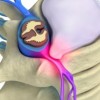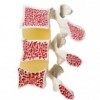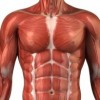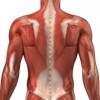Chest & Mid Back
Thoracic Disc Herniation - Slipped Disc Mid Back
A thoracic disc herniation often causes severe mid back pain. The disc often presses on a nerve root which also causes pain and other symptoms like pins & needles, weakness and numbness in the back around the side and into the chest and stomach. Actions like sneezing, coughing and bending to the side aggravate pain levels. Characteristically there is a sudden onset of pain, possibly after trauma with the likelihood of prior mid back complaints. It most commonly develops within the 25-50 year old age range with the highest incidence between 35-45 years. In most cases, the symptoms ease off gradually over several weeks.
Osteoporosis is a progressive condition that causes a weakening of the inner structure of the bone. Thoracic osteoporosis affects the spinal vertebrae bones of the low back in particular the vertebrae bodies, which form the spinal column. Osteoporosis is a silent and gradual condition that emits no symptoms. There is often no way of knowing you have osteoporosis until you experience a minor fall or knock that results in a fracture, which normal healthy bones would have been able to withstand.
For those who do experience pain it is normally sudden and severe pain in the mid back with immediate onset after or during the injury. The pain levels are aggravated by any lifting or standing and walking for two long. Flexing and twisting the back is also painful and may be accompanied by intense muscle spasms.
Chest - Myofascial Pain Syndrome (muscle pain)
Myofascial pain (muscle pain) can result from sprains or strains of a joint, excessive repetitive movements and high stress levels. Risk factors like poor posture, fatigue, heavy lifting and even muscle weakness may make you more susceptible to myofascial pain. Specific causes like stress, normally cause quite a lot of tension in the upper back and neck which can then lead to quite bad headaches.
Symptoms range from a sudden sharp pain, spasms and burning pain to a gradual build-up of a dull ache and discomfort that is worse in the evening after long days at work or activity. Muscle knots and trigger points can cause pain to refer from the injured muscle to the surrounding areas.
Mid Back - Myofascial Pain Syndrome (muscle pain)
Myofascial pain (muscle pain) can result from sprains or strains of a joint, excessive repetitive movements and high stress levels. Risk factors like poor posture, fatigue, heavy lifting and even muscle weakness may make you more susceptible to myofascial pain. Specific causes like stress, normally cause quite a lot of tension in the upper back and neck which can then lead to quite bad headaches.
Symptoms range from a sudden sharp pain, spasms and burning pain to a gradual buildup of a dull ache and discomfort that is worse in the evening after long days at work or activity. Muscle knots and trigger points can cause pain to refer from the injured muscle to the surrounding areas.




